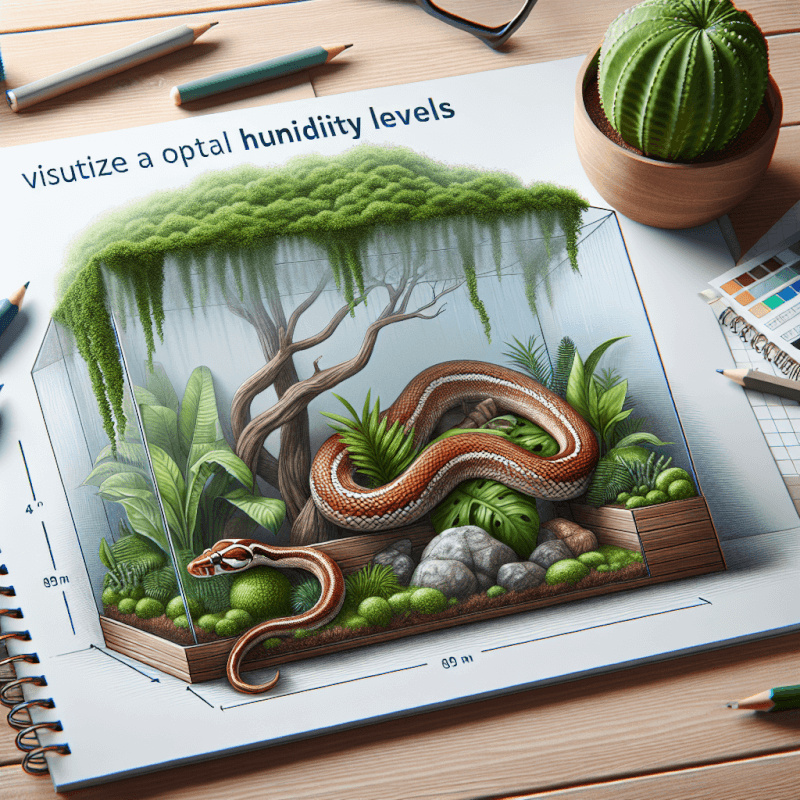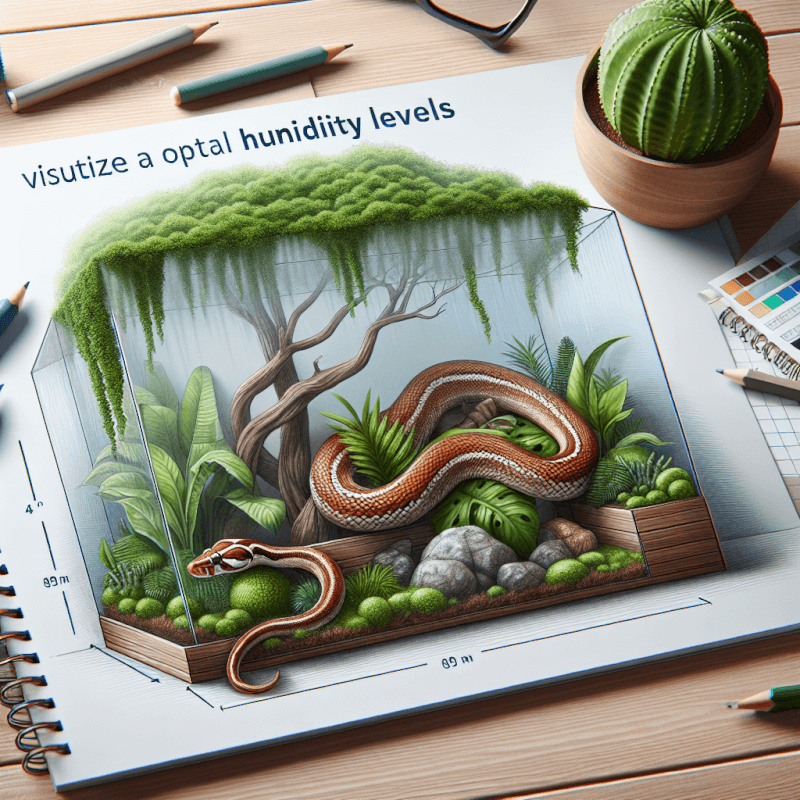Are you a proud owner of a corn snake? If so, you may be wondering what the perfect humidity level is for your scaly companion’s enclosure. Maintaining the right humidity is an essential aspect of keeping your corn snake healthy and happy. In this article, we will explore the ideal humidity level for a corn snake’s enclosure, providing you with the knowledge you need to create the perfect environment for your slithering friend. So, let’s dive into the world of corn snake care and discover how to ensure their enclosure is just the right amount of humid.
Understanding the Importance of Humidity for Corn Snakes
Why is humidity important for corn snakes?
Humidity plays a crucial role in the health and well-being of corn snakes. These reptiles originate from the southeastern United States, where they naturally thrive in environments with moderate to high humidity. In their natural habitat, the humidity levels can range from 40% to 70%. Providing the appropriate humidity in captivity is essential for maintaining their overall health, hydration, and proper shedding processes.
How does humidity affect a corn snake’s health?
The humidity level within a corn snake’s enclosure directly impacts its respiratory system and hydration. Corn snakes, like all reptiles, have specialized lungs that require adequate moisture to function properly. The air they breathe needs to be humid enough to prevent drying out of their delicate lung tissues.
Additionally, humidity affects a corn snake’s ability to stay hydrated. By maintaining the correct humidity level, you are ensuring that your snake’s skin and scales retain the necessary moisture. This helps prevent dehydration and promotes healthy shedding, preventing the risk of stuck shed or incomplete molting.
What are the risks of improper humidity levels?
Failure to provide appropriate humidity levels can lead to various health issues for corn snakes. If the humidity is too low, it can cause dehydration, respiratory problems, and difficulties with shedding. Insufficient humidity can result in flaky and dry skin, leading to the formation of stuck shed or retained eye caps, which can be painful and may cause serious complications.
On the other hand, excessive humidity can create a breeding ground for harmful bacteria and fungi. High humidity can promote the growth of mold or mildew within the enclosure, posing a risk to your snake’s respiratory health if inhaled or ingested. It can also cause scale rot, a bacterial infection that affects the scales and tissue of the snake, leading to severe pain, discomfort, and potential complications.
The natural habitat of corn snakes
To truly understand the humidity requirements of corn snakes, it is essential to consider their natural habitat. Corn snakes are primarily found in the southeastern United States, where they inhabit forests, grasslands, and farmlands. These environments have relatively high humidity levels due to factors such as proximity to water sources and the presence of vegetation.
In their native habitat, corn snakes can retreat to burrows, hollow logs, and other sheltered areas to regulate their humidity levels. These features provide opportunities for them to seek out humidity gradients and find their preferred microclimates within the overall environment.
Factors Influencing Humidity Levels
Temperature
Temperature plays a significant role in humidity regulation within a corn snake’s enclosure. Warmer air has a higher capacity to hold moisture, resulting in higher humidity levels. Optimal temperatures for corn snakes generally range from 75 to 85 degrees Fahrenheit (24 to 29 degrees Celsius). Maintaining appropriate temperatures in conjunction with humidity management is crucial for your snake’s overall health.
Ventilation and airflow
Proper ventilation and airflow within the enclosure are essential for maintaining humidity levels. Good airflow prevents stagnant air and helps regulate the distribution of humidity throughout the enclosure. Insufficient ventilation can result in stagnant, humid conditions, leading to increased bacterial and fungal growth. On the other hand, excessive airflow without proper humidity control can quickly dry out the enclosure, causing low humidity levels.
Substrate
The substrate used in the enclosure can significantly impact humidity levels. Certain substrates, such as coconut husk fiber or sphagnum moss, have natural moisture-retaining properties and can help maintain humidity. These substrates can be misted to provide additional moisture when needed. Avoid using substrates that are too dry or absorbent, as they can interfere with humidity regulation.
Water source
Providing a suitable water source within the enclosure is essential for maintaining humidity levels. A large, stable water dish allows the snake to drink and soak, promoting hydration and boosting humidity through evaporation. Ensure the water dish is of sufficient size to prevent spills and maintain consistent water levels. The presence of a water source also helps simulate the natural habitat of corn snakes, contributing to their overall well-being.

Recommended Humidity Range
Optimal humidity level for corn snakes
The optimal humidity range for corn snakes is generally around 40% to 60%. This range provides adequate moisture for their respiratory system, hydration, and shedding. It is important to maintain consistency within this range to prevent any adverse health effects.
Humidity ranges for different life stages
The humidity requirements of corn snakes may vary slightly depending on their life stage. Newborn and juvenile corn snakes require slightly higher humidity levels, around 50% to 70%, to support proper growth and shedding. As they mature, they gradually adapt to the lower end of the optimal range, 40% to 60%.
Seasonal variations in humidity
Seasonal variations in humidity closely mimic the natural conditions corn snakes would experience in the wild. During the shedding process, which occurs periodically throughout their lives, slightly higher humidity levels may be necessary to facilitate the shedding of old skin. In the colder months, when heating systems may affect ambient humidity, it is crucial to monitor and adjust humidity levels to ensure consistency.
Importance of monitoring humidity levels
Consistently monitoring humidity levels within the enclosure is essential to ensure your corn snake’s well-being. Using a reliable hygrometer, which measures humidity, is highly recommended to accurately monitor and regulate humidity levels. Regular checks and adjustments will help prevent any potential health issues associated with improper humidity.
Methods to Measure Humidity
Hygrometers and their accuracy
Hygrometers are devices specifically designed to measure humidity levels. They come in various types, including analog and digital models. Digital hygrometers are generally more accurate and offer easier readouts. It is important to invest in a high-quality and reliable hygrometer to obtain accurate readings.
Placement of hygrometer
Proper placement of the hygrometer within the enclosure is critical to obtaining accurate humidity readings. Avoid placing it in direct contact with the heat source or water dish, as this may lead to incorrect readings. Position the hygrometer at mid-level within the enclosure, preferably at a location that represents the average temperature and humidity experienced by the snake.
Alternative methods to measure humidity
In addition to using hygrometers, there are alternative methods to assess humidity levels within the enclosure. One such method is the “eye test.” By observing the snake’s behavior and the condensation on the enclosure walls, you can get a rough idea of the humidity level. However, these methods are not as accurate as using a hygrometer, and they should be complemented with frequent hygrometer readings.

Effective Strategies to Increase Humidity
Misting the enclosure
Misting the enclosure with water can be an effective way to increase humidity levels, especially during shedding or in drier climates. Use a spray bottle with a fine mist setting to evenly distribute water throughout the enclosure. Be cautious not to oversaturate the substrate, as excessive moisture can lead to bacterial and fungal growth.
Using a humidifier
In cases where consistent humidity levels are difficult to achieve, especially in arid climates or during winter months when heating systems are in use, employing a humidifier can prove beneficial. A reptile-specific humidifier or a general household humidifier can be used to add moisture to the air within the enclosure. Ensure proper ventilation to prevent excessive humidity and monitor humidity levels closely.
Adding a humidity box
Creating a humidity box within the enclosure can provide a microclimate with elevated humidity. To create a humidity box, place a small, sealed container with a lid inside the enclosure. Fill it with damp sphagnum moss or paper towel material, which will release moisture into the surrounding air. This allows your snake to retreat to the box when it requires additional humidity.
Choosing suitable substrate
Selecting an appropriate substrate can significantly impact humidity levels within the enclosure. Materials such as coconut husk fiber, cypress mulch, or a mix of these can provide good moisture retention. These substrates can be misted with water to increase humidity levels, if needed. Avoid using substrates that quickly dry out or absorb moisture excessively, as they can interfere with humidity regulation.
Mitigating High Humidity Levels
Importance of proper ventilation
Maintaining proper ventilation is crucial in preventing excessively high humidity levels within the snake’s enclosure. Adequate ventilation helps dissipate excess moisture and prevent the formation of stagnant, humid conditions that can promote bacterial and fungal growth. Ensure that the enclosure has appropriate vents or mesh sides to allow for proper airflow.
Reducing substrate moisture
If humidity levels are consistently high, reducing moisture content in the substrate can help reduce humidity. Allow the substrate to dry out slightly before misting it again. Avoid overwatering or using substrates with excessive moisture-absorbing capabilities, as they can contribute to high humidity levels.
Controlling water sources
Monitoring and controlling the water sources within the enclosure can help mitigate high humidity levels. If the enclosure has a large water dish, reducing its size or removing it temporarily can help decrease humidity. Alternatively, using a shallow water dish instead of a deep one can limit the amount of water available for evaporation, reducing humidity levels.

Maintaining Stable Humidity Levels
Proper enclosure setup
Ensure that the snake’s enclosure is properly set up to optimize humidity regulation. This includes maintaining correct temperature gradients, providing adequate ventilation, and using suitable substrate. Creating a suitable hiding spot, such as a humid hide or humidity box, can further assist in maintaining stable humidity levels.
Regular monitoring and adjustments
Consistently monitor humidity levels within the enclosure using a reliable hygrometer. Regularly check the hygrometer readings and make adjustments as necessary to maintain the desired humidity range. Remember to consider seasonal variations and the snake’s life stage when making adjustments.
Assessing snake behavior and shedding
Observing your corn snake’s behavior and monitoring its shedding process can provide valuable insights into the enclosure’s humidity levels. If you notice signs of dry or incomplete shedding, such as retained eye caps or stuck shed, it may indicate a need for increased humidity. Conversely, excessive moisture within the enclosure can lead to respiratory issues and contribute to mold growth.
Importance of proper cleaning and maintenance
Maintaining proper cleanliness and hygiene practices within the snake’s enclosure is essential for maintaining stable humidity levels. Regularly clean and replace soiled substrate, remove any leftover food, and clean the water dish to prevent bacterial growth. A clean and well-maintained environment contributes to a healthier snake and helps prevent humidity-related issues.
Common Issues and Solutions
Mold or mildew growth
Excessive humidity levels, combined with poor ventilation, can create a favorable environment for mold or mildew growth within the enclosure. If you notice signs of mold or mildew, such as a musty smell, discolored or fuzzy patches, or respiratory issues in your snake, immediate action is necessary. It is crucial to reduce the humidity levels, improve ventilation, and thoroughly clean and disinfect the enclosure to eliminate the mold or mildew.
Respiratory problems
Both low and high humidity levels can contribute to respiratory problems in corn snakes. Respiratory issues often present with symptoms such as wheezing, gasping for breath, open-mouth breathing, or excessive mucus. Consult with a reptile veterinarian for a proper diagnosis and treatment. Providing appropriate humidity levels, maintaining proper ventilation, and addressing any underlying health issues can help alleviate respiratory problems.
Inadequate shedding
Inadequate shedding, commonly known as stuck shed, occurs when the snake’s skin fails to fully shed off during the molting process. Improper humidity levels, either too low or too high, can contribute to this issue. To address stuck shed, increase humidity levels within the enclosure and provide your snake with a damp hide or a humidity box. Consult with a reptile veterinarian if the problem persists.
Dehydration
Insufficient humidity within the snake’s enclosure can lead to dehydration, which can have severe health consequences. Signs of dehydration include sunken eyes, wrinkled skin, loss of appetite, and overall lethargy. If you suspect your snake is dehydrated, increase humidity levels and make sure it has access to fresh water. If symptoms persist, consult a reptile veterinarian for proper hydration and treatment.
Scale rot
Scale rot is a bacterial infection that affects the scales and underlying tissues of snakes. It is caused by prolonged exposure to excessively high humidity levels and damp substrates. Early signs of scale rot include discoloration or blistering of the scales, swollen areas, and local discomfort. If scale rot is suspected, promptly address the underlying humidity issue, thoroughly clean and disinfect the enclosure, and consult a reptile veterinarian for appropriate treatment.

Seeking Veterinary Assistance
Identifying signs of humidity-related issues
As a responsible snake owner, it is essential to be aware of potential signs of humidity-related issues in your corn snake. These may include changes in behavior, such as increased restlessness, reduced appetite, respiratory symptoms, or abnormalities during shedding. Regularly observing and monitoring your snake’s overall health and behavior will help you identify any potential problems early on.
When to consult a reptile veterinarian
If you notice any signs of respiratory distress, persistent shedding issues, scale damage or infections, or other severe health concerns in your corn snake, it is crucial to seek veterinary assistance. A reptile veterinarian will be able to evaluate your snake’s condition, provide a proper diagnosis, and recommend the necessary treatment based on the specific humidity-related issue.
Treatment options for humidity-related health problems
Treatment for humidity-related health problems in corn snakes will vary depending on the specific issue. A reptile veterinarian may recommend adjustments to humidity levels, medications to address bacterial or fungal infections, or other treatments tailored to the snake’s condition. It is important to follow their guidance closely and maintain the recommended humidity levels to ensure your snake’s recovery and ongoing well-being.
Conclusion
Understanding and maintaining appropriate humidity levels is essential for the health and well-being of corn snakes. By providing the optimal humidity range, monitoring humidity levels regularly, and implementing effective strategies to increase or decrease humidity as needed, you can ensure your corn snake thrives in a suitable environment. Remember, maintaining proper ventilation, choosing suitable substrates, and seeking veterinary assistance when necessary are crucial aspects of successful humidity management. With the right care and attention, you can help your corn snake live a healthy, fulfilling life.



